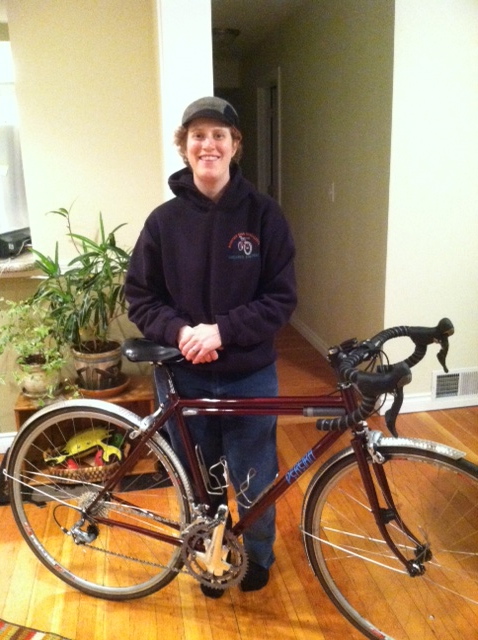Pedaling Your Way
Fit Your Frame
Remember, only you know how you feel on your bike. You’re the ultimate expert!
Last month I wrote about three local frame builders. Not everyone wants a custom frame or can spend over $3,000 for a new bike. For some of us, another factor is the inability to make all those decisions.

At least twice a year, I go to the Converse website and start the process of specifying my own design for a new pair of Chuck Taylor hi-top sneakers. Halfway through I’m tormented by too many decisions and instead buy a pair of black, grey, or blue. Think you want a hand-built bike and can make the choices? Try my Converse test.
Some riders can make all those decisions. My daughter, Danielle, just bought a beautiful custom bicycle. She’s incredibly proud of her new maroon Pereira Cycle with fenders and a pump painted to match!
If a hand-built bike isn’t for you, then you may want to consider having your bike custom-fitted. I ride every day and believe that how comfortable you are on your bike is easily the most important aspect of selecting a bike. Believe me, fit is way more important than the right color frame or debating the virtues of carbon vs. steel vs. aluminum. One thing matters more than anything else when you select a new bike — that it fits you!
A bike fit doesn’t have to be complicated and expensive. If you borrow a friend’s bike or maybe take a trip to Washington, D.C., and rent one of the 1,200 new Bikeshare cycles, don’t just jump on and ride off. It’s easy to adjust the seat to the right height. What’s the right height? When sitting on the saddle with your foot on the pedal when the pedal is closest to the ground, your knees should be slightly bent. Take a minute and your knees will thank you! It’s also not a bad idea to do a quick safety check: Tires have air, wheels spin smoothly, brakes and lights work, nothing rattles or falls off the bike.
When I bought my first road bike, years ago, the adjustments before I rode off were a simple two-step process. Step 1: Could I straddle the frame? Step 2: Could I reach the pedals? Done! But it’s still simple enough, honest. Fitting a bike often seems to be a mysterious process filled with charts, graphs, computer programs, plumb bobs, rules of thumb, and arcane measuring devices not seen since the days of Leonardo da Vinci. Forget all of that.
If you’re a casual rider who’s just bought a new bike, your local shop will make sure that some simple adjustments are completed before you roll our the door. They’ll check saddle height and position, stem length, and handlebar height so that you’ll ride comfortably and safely. You ride a bike that fits you well with more power, and yet the effort comes easier. Your body is relaxed, and bike-handling skills are almost second nature.
The art and science of matching your human peculiarities to a mechanical propulsion system involves compromises — for example, between comfort and performance, quick acceleration and handling ease, top speed and strolling through the tulips as a tourist. And if you ride frequently or long distances, you’re probably ready for a custom fit.
Before you get a custom fit, the first questions to ask yourself are, simply, “What do I want to do with my bike?” and “Why am I riding?” Your body contacts the bicycle in three areas: hands, seat, and feet. The relative positions of each determine your comfort and efficiency on the bike. There are many variables that determine these positions: crank length, distance from crank center or bottom bracket to saddle, saddle angle, seat-tube angle and saddle offset, distance from saddle to handlebar, relative height of saddle and handlebar, handlebar width, and handlebar drop on road-style handlebars. Sounds complex, but remember, the arcane ergonomic jargon will always come down to hands, seat, and feet.
Setting up your ideal position on a bike takes some time and requires patience and perseverance. There is so much conflicting advice — bike magazines say one thing, our fellow riders tell us something different, and the Internet has endless additional blogs, charts, and videos. My advice: Go talk to an expert.

Before my daughter bought her new bike, she and Tony Pereira spent a lot of time talking about where she was going to ride, how she was going to use the bike, and her level of fitness. She was carefully measured, and Tony designed the frame for her riding style and body measurements. To achieve a perfect fit, Danielle has spent hours riding the bike and then adjusting seat height, stem length, and saddle angle. It will take awhile for her new friend to feel like an old friend.
You have to decide for yourself your best position on a bike because variances in body sizes and proportions, fitness and flexibility, technique and style all impact comfort. Take me for example. I started riding seriously in the mid 1970s. After much trial and error, I arrived at a setup that worked for me. I haven’t gotten any taller or shorter, and my arms haven’t grown or shrunk, but my neck is a lot stiffer now than when I was younger. Today, I need a handlebar position higher than in 1976 or my neck will be sore after a few miles of riding. Would measuring my body tell me that the handlebar needs to be higher? No!
Pick up some wrenches. You can quickly start adjusting your bike to fit you. Not a do-it-yourselfer? Then roll your bike and body into one of our area bike shops. They’ll be happy to do a quick fit or schedule a complete custom fit.
Remember, there is only one expert when it comes to your bike. Only you know how you feel on your bike. You’re the expert!



